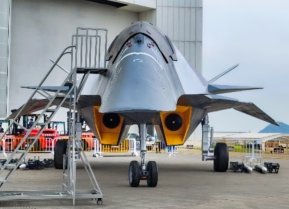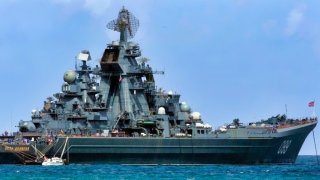Russia’s Kirov-class Battlecruisers Explained in 5 Words
The main point of the Kirov-class battlecruiser was to knock out America’s vaunted carrier force and to scatter American submarines. Soviet naval planners, however, had other ideas for the Kirov-class battlecruisers.
Built to Fight U.S. Navy: The Cold War was an era in which many new and interesting weapons designs were being tested. Of course, the prospect of nuclear warfare was ever-present. But there were many who came to believe that nuclear warfare was winnable. Even those who did not believe that, thought that neither the Soviet Union nor the United States would risk nuclear warfare because of how destructive such a conflict would be. That didn’t mean that the two sides were pacifistic. It just meant that the two sides assumed conflict would be kept below the nuclear threshold.
This erroneous assumption pervades most strategic thinking today. But this essay is about why the Soviet Red Navy built the Kirov-class nuclear-powered guided-missile battlecruisers.
The point of these ships
These beasts plied the High Seas, looking more like monsters from ancient mythology than warships. Bristling with weapons, armed to the teeth, and given one mission: if a war between the United States and USSR ever occurred, these steel leviathans would hunt down American aircraft carriers and sink them before they could truly threaten Soviet assets.
So, even though the Soviet Navy’s surface warfare fleet was nowhere near as globally powerful as the U.S. Navy, with its fleet of aircraft carriers, the Red Navy’s surface fleet packed a potent punch in the form of the Kirovs.
Kirov-class battlecruisers were also designed to counter the U.S. Navy’s submarine force (they carried a large payload of SS-N-14 anti-submarine missiles). Powered by nuclear reactors, these warships could cover a range of 14,000 nautical miles at 30 knots. These beastly battlecruisers come equipped with an impressive array of weapons, too, including twin main launchers that can fire SA-N-4 surface-to-air missiles (with a total of forty missiles loaded) and the aforementioned SS-N-19 Shipwreck long-range anti-ship missiles. These boats have twelve eight-round Vertical Launch Systems.
The designers installed two octuple launchers at the forward deck for the SA-N-9 surface-to-air missiles (sixteen of these are carried in those octuple launchers). As part of their impressive weapons package, the Kirovs came equipped with 533 mm torpedo tubes. These tubes can launch the Type 53 torpedo or the SS-N-15 missile. A single RBU-1200 is located at the forward deck while two RBU-1000s will be found at the aft deck.
Kirov-class battlecruisers are further defended by CADS-N-1 Close-In Weapon Systems (CIWS) armed with SA-N-11 missiles. Six of these CIWS weapons were placed along the warship’s superstructure, creating a formidable point of defense against incoming enemy fire.
A potent weapon
As noted above, the main point of the Kirov-class battlecruiser was to knock out America’s vaunted carrier force and to scatter American submarines. Soviet naval planners, however, had other ideas for the Kirov-class battlecruisers, too. One of them was to use these warships as commerce raiders that would stymie American and Canadian ground reinforcements to Europe if a real, hot war ever erupted between the Americans (and their allies) and the Soviets in Europe.
The Kirov-class battlecruiser was an interesting move by the Soviets. It was a clear acknowledgment that the Soviets were not a real carrier power, like the Americans. But it also revealed the Soviets’ recognition that they needed to knock out America’s carriers when the war began. The Soviets had no intention, though, of being left in the strategic dust at sea.

They developed a real capability to deny U.S. Navy elements of clear, easy access to the waterways around Europe, where a world war between the USSR and the United States was most likely to erupt.
About the Author
Brandon J. Weichert, a National Interest national security analyst, is a former Congressional staffer and geopolitical analyst who is a contributor at The Washington Times, the Asia Times, and The-Pipeline. He is the author of Winning Space: How America Remains a Superpower, Biohacked: China’s Race to Control Life, and The Shadow War: Iran’s Quest for Supremacy. His next book, A Disaster of Our Own Making: How the West Lost Ukraine, is available for purchase wherever books are sold. Weichert can be followed via Twitter @WeTheBrandon.
Image Credit: Creative Commons.


